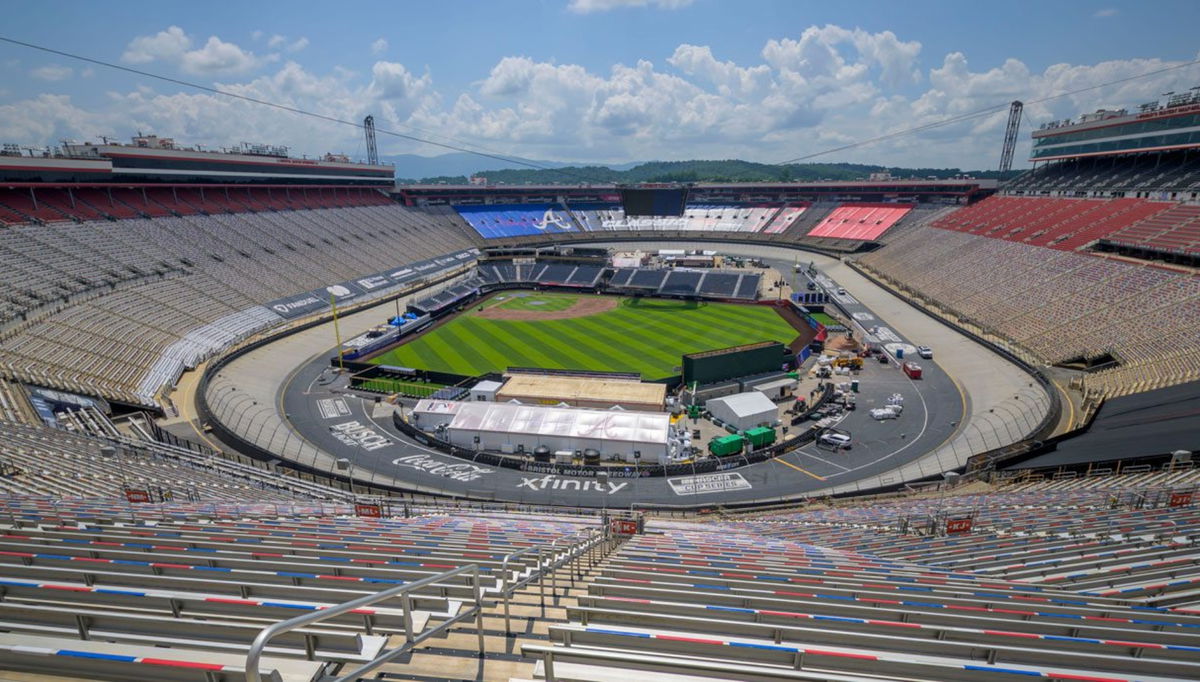
Imago
via NASCAR.com

Imago
via NASCAR.com
When Bristol Motor Speedway transformed into a baseball stadium on August 2, it was a radical spectacle. The Atlanta Braves took on the Cincinnati Reds in Tennessee’s first-ever regular-season MLB game at the venue. Over 85,000 tickets were sold, smashing the prior MLB regular-season attendance record of 84,587 set in 1954. A 400-person crew laid 17,000 tons of gravel, 340 tons of Pennsylvania clay, and 124,000ft² of AstroTurf, completely reshaping the infield into a regulation baseball diamond. Accompanying the game was a full fan festival and performances by artists like Tim McGraw and Pitbull, also joined by NASCAR stars like Chase Elliott and Kyle Busch. The result was a cultural collision that drew national attention and showed Bristol’s versatility beyond stock cars. But beyond the records, another story was quietly unfolding, one rooted in recovery and resilience.
Watch What’s Trending Now!
Long before hosting baseball legends and roaring crowds, Bristol transformed into a lifeline for communities battered by Hurricane Helene’s floods in late 2024. The speedway was designated the Northeast Tennessee Disaster Relief Center, serving as a hub for donation drives, logistics coordination, and staging for search-and-rescue missions across counties, including Unicoi, Greene, and Cocke. Speedway Motorsports’ crews opened campgrounds to relief workers, donated supplies, and offered operational space, putting tracks aside to become a center of hope during the crisis. In recognition of its efforts, Bristol earned an EMAT Business & Industry Award for service excellence. And once again, the Speedway is stepping up to support the victims of Mother Nature’s unforgiving wrath.
ADVERTISEMENT
Turning grandstand lumber into lifelines
After hosting the historic MLB Speedway Classic, Bristol Motor Speedway made it clear that the transformation back to NASCAR form would also serve a deeper purpose: helping communities still reeling from the devastation of Hurricane Helene. Steve Swift, Speedway Motorsports’ Senior Vice President of operations, revealed that much of the temporary infrastructure used for the baseball event, everything from 2x4s and plywood from the grandstands to truckloads of gravel, would be repurposed for relief efforts. “A lot of stuff is going to go to good use as far as the rebuild portion,” Swift said. “We just need to get it out of the way so we can put back asphalt and concrete.” That dual mission, meeting the NASCAR Playoff schedule while aiding disaster victims, has given Bristol’s latest transformation an added sense of urgency and meaning.
The logistical challenge is monumental. In just over a month, The Last Great Colosseum went from a roaring baseball crowd to the grind of demolition and rebuild work. Swift explained the rapid timeline, saying, “As soon as the last pitch is thrown, the last hit’s hit, teams do their thing, postgame’s taken care of, pads will start coming off the wall, and they’ll work through the night to basically start disassembling so we can reassemble for the NASCAR race.” Major League Baseball‘s setup had required a complete overhaul of the infield, including clubhouses for the Atlanta Braves and Cincinnati Reds, showers, strength and conditioning rooms, coach and trainer offices, and batting cages. Grandstands stretched along both baselines with broadcast booths perched above, all of which now must be removed and recycled before the racing surface returns.
The engineering effort is no less impressive than the humanitarian one. Pit walls taken down to accommodate baseball sightlines must be rebuilt from scratch, a process slowed by the curing time of concrete. While additives can speed up curing, Swift noted that’s only one of the many obstacles. The transformation from racetrack to ballpark had required tons of gravel and Pennsylvania clay for the playing surface. Braves’ first baseman Matt Olson admitted, “couldn’t believe Bristol was transformed all for one game.” That same gravel will now be used to improve the track’s parking lots, while salvaged building materials head straight to hurricane recovery projects.
ADVERTISEMENT
“[SMI exec Steve] Swift said they have found groups to help use some of the materials [from the Speedway Classic] to help people still recovering from the damages left by Hurricane Helene. That includes 2x4s and plywood used for the grandstands.” – @AP https://t.co/6P92dBPF0S
— Adam Stern (@A_S12) August 4, 2025
The timeline to pull it all off is tight. Bristol’s renovation schedule includes only a couple of buffer days, with a target of September 7 to complete the transformation, just six days before the NASCAR Cup Series Playoff race on September 13. “There may still be some paint drying whenever they roll in with the Goodyear haulers, but we’ll definitely shoot for that (Sept. 7) day,” Swift said. “And at the latest, we’re looking at Tuesday.” Those dates are non-negotiable in the high-stakes world of playoff racing, where every detail, from pit road markings to hospitality suites, must be ready for national broadcast and tens of thousands of ticket holders.
ADVERTISEMENT
Bristol‘s ambitions don’t stop with baseball and stock cars either. This is the same track that hosted a record-setting 156,990 fans for a college football game in 2016, and now it may add the NHL to its resume. League officials will visit to evaluate whether an outdoor hockey game could be staged inside the speedway. Swift didn’t dismiss the idea, saying, “A hockey rink would be similar to a football field and [Speedway Motorsports] has big dreams for what is possible at places like Bristol. We’ve shown with football and now baseball being here, that things can take place and we can do the things that nobody would even think about.”
With its unique blend of vision, adaptability, and community focus, Bristol continues to prove that it’s more than just a racetrack; it’s an arena where history, sport, and service collide.
Top Stories
FOX Earns Rare Moment of Respect as NFL Honors NASCAR Legend Live on Air

NASCAR Radio Host Rejects Denny Hamlin’s Warning Amidst Call for Ex-Fox Broadcaster’s Apology

Corey LaJoie Pokes Joey Logano With Backhanded Dig After Star NFL Appearance

Ford Star’s Future in Doubt as 33-Year-Old Rumored to Jump Ship Amid Contract Uncertainty

Racing Broadcaster Gets Emotional as He Warns Fans Against What NASCAR Has Lost

ADVERTISEMENT
Marcus Smith’s ambitious plan for Bristol’s development
Bristol Motor Speedway has a long history of thinking big, from the dirt experiment in 2021 to hosting a record-breaking 156,000 fans for the 2016 Battle at Bristol football game and, recently, the MLB game. A few weeks back, Marcus Smith, CEO of Speedway Motorsports, floated his boldest idea yet of putting a roof over the speedway. “The dream, I think, the thing that would be awesome to do…is to put a roof on Bristol one day. I would love that… But yeah, a roof on Bristol would be a big dream. That’d be pretty wild. It’s doable,” Smith told Kevin Harvick, envisioning a venue shielded from Tennessee’s sudden storms and with its already deafening race-day noise amplified even more.
Enclosing a 146,000-seat oval, however, is no small feat. Past studies flagged three major challenges, including ventilation, noise control, and cost. A 2021 architect estimated a dome would cost at least $80 million, factoring in the reinforced supports needed to withstand heavy rain, snow, and wind loads. Ventilation remains the biggest safety concern, as 36-40 roaring Cup engines produce far more exhaust than a single car test. Smith acknowledged these challenges but pointed to advances in materials and retractable-roof designs, like Atlanta’s Mercedes-Benz Stadium, as proof that modern engineering could make it possible.
Integrating a roof without killing Bristol’s electric atmosphere would require precision. Engineers would need to ensure safe air exchange rates, control echoes, and mount lighting, video boards, and safety rigs to the dome without disrupting sightlines. The payoff could be enormous: year-round usability and marquee events in any weather. But for NASCAR purists, enclosing Bristol raises the question: can the sport’s most raucous short-track keep its raw edge under a roof?
ADVERTISEMENT
ADVERTISEMENT
ADVERTISEMENT
ADVERTISEMENT

